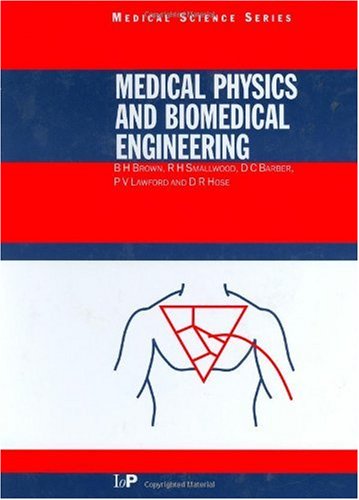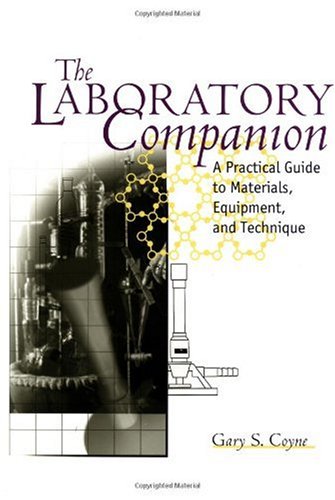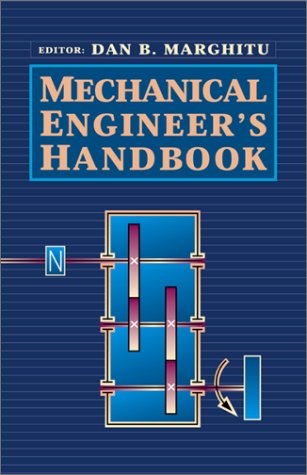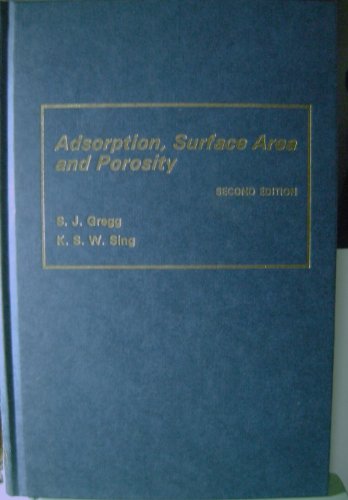B.H Brown, R.H Smallwood, D.C. Barber, P.V Lawford, D.R Hose0750303670, 9780750303675, 0750303689, 9780750303682
Table of contents :
MEDICAL PHYSICS AND BIOMEDICAL ENGINEERING……Page 1
CONTENTS……Page 5
PREFACE……Page 19
PREFACE TO ‘MEDICAL PHYSICS AND PHYSIOLOGICAL MEASUREMENT’……Page 21
NOTES TO READERS……Page 23
ACKNOWLEDGMENTS……Page 24
1.2.1. Stress/strain relationships: the constitutive equation……Page 25
1.2.2. Bone……Page 29
1.2.4. Viscoelasticity……Page 31
1.3.1. Forces, moments and couples……Page 36
1.3.2. Equations of static equilibrium……Page 37
1.3.3. Structural idealizations……Page 38
1.3.4. Applications in biomechanics……Page 39
1.4.1. Tension and compression……Page 40
1.4.2. Bending……Page 41
1.4.3. Shear stresses and torsion……Page 45
1.5.2. Where instability occurs……Page 47
1.5.3. Buckling of columns: Euler theory……Page 48
1.5.4. Compressive failure of the long bones……Page 49
1.6.1. Work, potential energy, kinetic energy and strain energy……Page 50
1.6.2. Applications of the principle of conservation of energy……Page 52
1.7. KINEMATICS AND KINETICS……Page 53
1.7.2. Walking and running……Page 55
1.8.1. Geometric similarity and animal performance……Page 59
1.9.1. Short questions……Page 60
Question 1.9.2.1……Page 61
Question 1.9.2.3……Page 63
Question 1.9.2.4……Page 65
Question 1.9.2.5……Page 66
BIBLIOGRAPHY……Page 69
2.1. INTRODUCTION AND OBJECTIVES……Page 70
2.2.1. Pressure in the cardiovascular system……Page 71
2.2.2. Hydrostatic pressure……Page 72
2.2.3. Bladder pressure……Page 73
2.2.6. Eye and ear pressures……Page 74
2.3.2. Other viscosity models……Page 75
2.3.3. Rheology of blood……Page 76
2.4.1. The governing equations……Page 78
2.4.2. Classification of flows……Page 79
2.5.1. Steady laminar flow……Page 81
2.5.2. Turbulent and pulsatile flows……Page 85
2.5.3. Branching tubes……Page 86
2.6.1. Steady flow: Bernoulli’s equation and the continuity equation……Page 87
2.7.1. Windkessel theory……Page 90
2.7.2. Propagation of the pressure pulse: the Moens–Korteweg equation……Page 91
2.8. NUMERICAL METHODS IN BIOFLUID MECHANICS……Page 93
2.8.2. Discretization of the equations: finite difference versus finite element……Page 94
2.9.1. Short questions……Page 95
Question 2.9.2.2……Page 96
Question 2.9.2.4……Page 97
BIBLIOGRAPHY……Page 99
3.1. INTRODUCTION AND OBJECTIVES……Page 100
3.2.1. Mechanoreceptors……Page 101
3.2.2. Thermoreceptors……Page 103
3.3.1. Gustation (taste)……Page 104
3.4. AUDITION……Page 107
3.4.1. Physics of sound……Page 108
3.4.2. Normal sound levels……Page 115
3.4.3. Anatomy and physiology of the ear……Page 116
3.4.4. Theories of hearing……Page 121
3.4.5. Measurement of hearing……Page 122
3.5.1. Physics of light……Page 124
3.5.2. Anatomy and physiology of the eye……Page 128
3.5.3. Intensity of light……Page 131
3.5.4. Limits of vision……Page 133
3.5.5. Colour vision……Page 135
3.6. PSYCHOPHYSICS……Page 137
3.6.1. Weber and Fechner laws……Page 138
3.6.2. Power law……Page 139
Question 3.7.2.2……Page 140
Question 3.7.2.4……Page 141
Question 3.7.2.7……Page 142
BIBLIOGRAPHY……Page 143
4.1. INTRODUCTION AND OBJECTIVES……Page 144
4.2. BIOMATERIALS AND BIOCOMPATIBILITY……Page 145
4.2.1. Uses of biomaterials……Page 146
4.2.2. Selection of materials……Page 147
4.2.3. Types of biomaterials and their properties……Page 148
4.3. MATERIAL RESPONSE TO THE BIOLOGICAL ENVIRONMENT……Page 151
4.3.1. Metals……Page 152
4.3.2. Polymers and ceramics……Page 155
4.4. TISSUE RESPONSE TO THE BIOMATERIAL……Page 156
4.4.3. Carcinogenicity……Page 157
4.5.1. In vitro models……Page 158
4.5.2. In vivo models and clinical trials……Page 159
Question 4.6.2.2……Page 160
BIBLIOGRAPHY……Page 161
5.2. ABSORPTION, SCATTERING AND ATTENUATION OF GAMMA-RAYS……Page 163
5.2.2. Compton effect……Page 164
5.2.3. Pair production……Page 166
5.2.4. Energy spectra……Page 167
5.2.5. Inverse square law attenuation……Page 168
5.3. BIOLOGICAL EFFECTS AND PROTECTION FROM THEM……Page 169
5.4.1. Absorbed dose……Page 170
5.4.2. Dose equivalent……Page 171
5.5.1. Environmental dose……Page 172
5.6. MEASUREMENT METHODS……Page 173
5.6.1. Ionization chambers……Page 175
5.6.2. G-M counters……Page 176
5.6.3. Scintillation counters……Page 177
5.6.4. Film dosimeters……Page 180
5.6.5. Thermoluminescent dosimetry (TLD)……Page 182
5.7.1. Dose measurement during radiography……Page 184
Question 5.8.2.2……Page 185
Question 5.8.2.3……Page 186
BIBLIOGRAPHY……Page 187
6.1.1. Diagnosis with radioisotopes……Page 188
6.2.1. Isotopes……Page 189
6.2.2. Half-life……Page 190
6.2.3. Nuclear radiations……Page 191
6.2.4. Energy of nuclear radiations……Page 192
6.3.3. Induced background radiation……Page 193
6.3.5. Units of activity……Page 194
6.3.6. Isotope generators……Page 195
6.4.1. Counting statistics……Page 196
6.4.2. Sample counting……Page 197
6.4.3. Liquid scintillation counting……Page 201
6.5.2. Clearance measurements……Page 205
6.5.3. Surface counting……Page 206
6.5.4. Whole-body counting……Page 207
6.6.1. Haematological measurements……Page 208
6.6.2. Glomerular filtration rate……Page 212
6.7.1. Bone imaging……Page 213
6.7.2. Dynamic renal function……Page 214
6.7.3. Myocardial perfusion……Page 217
6.7.4. Quality assurance for gamma cameras……Page 220
6.8. TABLE OF APPLICATIONS……Page 223
Question 6.9.2.1……Page 226
Question 6.9.2.3……Page 227
Question 6.9.2.4……Page 228
Question 6.9.2.6……Page 229
Question 6.9.2.7……Page 230
BIBLIOGRAPHY……Page 231
7.1. INTRODUCTION AND OBJECTIVES……Page 232
7.3.1. Radiation from a plane circular piston……Page 233
7.3.2. Ultrasound transducers……Page 238
7.4.1. Reflection and refraction……Page 239
7.4.2. Absorption and scattering……Page 242
Question 7.5.2.2……Page 244
Question 7.5.2.3……Page 245
Question 7.5.2.4……Page 246
BIBLIOGRAPHY……Page 247
8.1. INTRODUCTION AND OBJECTIVES……Page 248
8.2. TISSUE AS A LEAKY DIELECTRIC……Page 249
8.3.1. Debye model……Page 251
8.3.2. Cole–Cole model……Page 253
8.4. OVERVIEW OF NON-IONIZING RADIATION EFFECTS……Page 255
8.5.1. Properties of tissue……Page 257
8.5.2. Neural effects……Page 259
8.5.3. Cardiac stimulation: fibrillation……Page 261
8.6.1. Surgical diathermy/electrosurgery……Page 262
8.6.2. Heating effects……Page 263
8.7. ULTRAVIOLET……Page 264
8.8.1. Physiological effects of electricity……Page 265
8.8.2. Leakage current……Page 267
8.8.3. Classification of equipment……Page 270
8.8.4. Acceptance and routine testing of equipment……Page 271
8.9.1. The measurement of earth leakage current……Page 273
8.9.2. Measurement of tissue anisotropy……Page 274
Question 8.10.2.1……Page 277
Question 8.10.2.5……Page 278
Question 8.10.2.7……Page 279
Question 8.10.2.9……Page 280
BIBLIOGRAPHY……Page 281
9.2. ELECTRODES……Page 282
9.2.1. Contact and polarization potentials……Page 283
9.2.2. Electrode equivalent circuits……Page 284
9.2.3. Types of electrode……Page 286
9.2.5. Reference electrodes……Page 287
9.3. THERMAL NOISE AND AMPLIFIERS……Page 288
9.3.2. Johnson noise……Page 289
9.3.3. Bioelectric amplifiers……Page 291
9.4. BIOMAGNETISM……Page 293
9.4.2. Magnetocardiogram (MCG) signals……Page 294
9.4.4. Interference and gradiometers……Page 296
9.4.5. Other magnetometers……Page 297
9.5.1. Temperature transducers……Page 299
9.5.2. Displacement transducers……Page 301
9.5.3. Gas-sensitive probes……Page 302
9.5.4. pH electrodes……Page 303
Question 9.6.1.1……Page 304
Question 9.6.2.2……Page 305
Question 9.6.2.6……Page 307
Question 9.6.2.8……Page 308
BIBLIOGRAPHY……Page 309
10.1. TESTING SYSTEMS BY EVOKING A RESPONSE……Page 310
10.1.1. Testing a linear system……Page 311
10.2.1. Nerve stimulation……Page 313
10.2.2. Currents and voltages……Page 314
10.2.3. Auditory and visual stimuli……Page 316
10.3. DETECTION OF SMALL SIGNALS……Page 317
10.3.2. Choice of amplifiers……Page 318
10.3.3. Differential amplifiers……Page 319
10.3.4. Principle of averaging……Page 322
10.4.1. Electric fields……Page 324
10.4.2. Magnetic fields……Page 325
10.4.3. Radio-frequency fields……Page 326
10.4.4. Acceptable levels of interference……Page 327
10.4.5. Screening and interference reduction……Page 329
10.5.1. Nerve action potentials……Page 330
10.5.2. EEG evoked responses……Page 331
10.5.3. Measurement of signal-to-noise ratio……Page 332
10.6.1. Short questions……Page 333
Question 10.6.2.2……Page 334
Question 10.6.2.3……Page 335
Question 10.6.2.5……Page 336
Question 10.6.2.6……Page 337
BIBLIOGRAPHY……Page 338
11.1. INTRODUCTION AND OBJECTIVES……Page 339
11.2.2. Linear systems……Page 341
11.3. THE IMAGING EQUATION……Page 342
11.3.2. Properties of the PSF……Page 344
11.3.4. Spatial linearity……Page 345
11.4. POSITION INDEPENDENCE……Page 346
11.4.1. Resolution……Page 347
11.4.2. Sensitivity……Page 349
11.4.4. Image magnification……Page 350
11.5. REDUCTION FROM THREE TO TWO DIMENSIONS……Page 351
11.6. NOISE……Page 352
11.7.1. The Fourier transform……Page 353
11.7.2. The shifting property……Page 355
11.7.4. The convolution equation……Page 356
11.8.1. Back-projection: the Radon transform……Page 357
11.9.1. Sampling on a grid……Page 361
11.9.2. Interpolating the image……Page 362
11.10.1. Short questions……Page 363
Question 11.10.2.1……Page 364
Question 11.10.2.4……Page 365
Question 11.10.2.7……Page 366
BIBLIOGRAPHY……Page 367
12.1. INTRODUCTION AND OBJECTIVES……Page 368
12.2.1. The gamma camera……Page 369
12.2.2. Energy discrimination……Page 372
12.2.3. Collimation……Page 373
12.2.4. Image display……Page 376
12.2.5. Single-photon emission tomography (SPET)……Page 377
12.2.6. Positron emission tomography (PET)……Page 378
12.3. ULTRASONIC IMAGING……Page 380
12.3.2. Ultrasound generation……Page 381
12.3.3. Tissue interaction with ultrasound……Page 383
12.3.4. Transducer arrays……Page 386
12.3.5. Applications……Page 390
12.3.6. Doppler imaging……Page 391
12.4.2. Precession in the presence of a magnetic field……Page 393
12.4.3. T1 and T2 relaxations……Page 396
12.4.4. The saturation recovery pulse sequence……Page 397
12.4.5. The spin–echo pulse sequence……Page 399
12.4.7. Frequency and phase encoding……Page 400
12.4.8. The FID and resolution……Page 403
12.4.9. Imaging and multiple slicing……Page 404
12.5.1. Absorption of x-rays……Page 406
12.5.2. Data collection……Page 407
12.5.4. Beam hardening……Page 408
12.5.5. Spiral CT……Page 409
12.6.1. Introduction and Ohm’s law……Page 410
12.6.2. Image reconstruction……Page 411
12.6.3. Data collection……Page 414
12.7.1. Short questions……Page 416
Question 12.7.2.1……Page 417
Question 12.7.2.2……Page 419
Question 12.7.2.5……Page 420
Question 12.7.2.7……Page 421
BIBLIOGRAPHY……Page 422
13.1. INTRODUCTION AND OBJECTIVES……Page 423
13.1.2. Signal description……Page 424
13.2.1. Sinusoidal waveform: frequency, amplitude and phase……Page 425
13.2.2. Orthogonality of sines, cosines and their harmonics……Page 426
13.2.3. Complex (exponential) form of trigonometric functions……Page 427
13.3.1. Curve fitting……Page 428
13.3.2. Periodic signals and the Fourier series……Page 429
13.3.3. Aperiodic functions, the Fourier integral and the Fourier transform……Page 433
13.3.4. Statistical descriptors of signals……Page 436
13.3.6. Autocorrelation function……Page 437
13.4.1. Functional description……Page 439
13.4.2. The delta function and its Fourier transform……Page 440
13.4.3. Discrete Fourier transform of an aperiodic signal……Page 441
13.4.4. The effect of a finite-sampling time……Page 443
13.5. APPLIED STATISTICS……Page 444
13.5.1. Data patterns and frequency distributions……Page 445
13.5.2. Data dispersion: standard deviation……Page 446
13.5.3. Probability and distributions……Page 447
13.5.4. Sources of variation……Page 450
13.5.5. Relationships between variables……Page 451
13.5.7. Confidence intervals……Page 452
13.5.8. Non-parametric statistics……Page 454
13.6. LINEAR SIGNAL PROCESSING……Page 455
13.6.2. Output from a general signal: the convolution integral……Page 456
13.6.3. Signal processing in the frequency domain: the convolution theorem……Page 459
13.7.1. Short questions……Page 460
Question 13.7.2.1……Page 461
Question 13.7.2.3……Page 462
Question 13.7.2.4……Page 463
Question 13.7.2.5……Page 464
Question 13.7.2.6……Page 465
BIBLIOGRAPHY……Page 466
14.2. DIGITAL IMAGES……Page 467
14.2.1. Image storage……Page 468
14.3. IMAGE DISPLAY……Page 469
14.3.1. Display mappings……Page 471
14.3.3. Optimal image mappings……Page 472
14.4. IMAGE PROCESSING……Page 474
14.4.1. Image smoothing……Page 475
14.4.2. Image restoration……Page 480
14.4.3. Image enhancement……Page 482
14.5.1. Image segmentation……Page 483
14.5.2. Intensity segmentation……Page 484
14.5.3. Edge detection……Page 485
14.5.4. Region growing……Page 486
14.5.5. Calculation of object intensity and the partial volume effect……Page 487
14.5.6. Regions of interest and dynamic studies……Page 488
14.5.7. Factor analysis……Page 490
14.6. IMAGE REGISTRATION……Page 491
14.7.1. Short questions……Page 495
Question 14.7.2.2……Page 496
Question 14.7.2.3……Page 497
Question 14.7.2.5……Page 498
Question 14.7.2.6……Page 499
BIBLIOGRAPHY……Page 501
15.1. INTRODUCTION AND OBJECTIVES……Page 502
15.2.1. Anatomy……Page 503
15.2.2. Sound waves……Page 505
15.2.3. Basic properties: dB scales……Page 506
15.2.4. Basic properties: transmission of sound……Page 507
15.2.5. Sound pressure level measurement……Page 508
15.3. BASIC MEASUREMENTS OF EAR FUNCTION……Page 510
15.3.1. Pure-tone audiometry: air conduction……Page 511
15.3.3. Masking……Page 512
15.3.4. Accuracy of measurement……Page 513
15.3.5. Middle-ear impedance audiometry: tympanometry……Page 514
15.3.6. Measurement of oto-acoustic emissions……Page 516
15.4.2. Conductive loss……Page 518
15.5. EVOKED RESPONSES: ELECTRIC RESPONSE AUDIOMETRY……Page 520
15.5.2. Auditory brainstem response……Page 521
15.5.3. Myogenic response……Page 523
15.5.4. Trans-tympanic electrocochleography……Page 524
15.6.1. Microphones and receivers……Page 525
15.6.2. Electronics and signal processing……Page 526
15.6.3. Types of aids……Page 527
15.6.4. Cochlear implants……Page 528
15.6.5. Sensory substitution aids……Page 530
15.8.1. Short questions……Page 531
Question 15.8.2.2……Page 532
Question 15.8.2.5……Page 533
BIBLIOGRAPHY……Page 534
16.1. INTRODUCTION AND OBJECTIVES: SOURCES OF BIOLOGICAL POTENTIALS……Page 535
16.1.1. The nervous system……Page 536
16.1.2. Neural communication……Page 538
16.1.3. The interface between ionic conductors: Nernst equation……Page 540
16.1.4. Membranes and nerve conduction……Page 541
16.1.5. Muscle action potentials……Page 544
16.1.6. Volume conductor effects……Page 545
16.2. THE ECG/EKG AND ITS DETECTION AND ANALYSIS……Page 547
16.2.1. Characteristics of the ECG/EKG……Page 549
16.2.2. The electrocardiographic planes……Page 550
16.2.3. Recording the ECG/EKG……Page 554
16.3. ELECTROENCEPHALOGRAPHIC (EEG) SIGNALS……Page 555
16.3.2. Equipment and normal settings……Page 556
16.3.3. Normal EEG signals……Page 557
16.4. ELECTROMYOGRAPHIC (EMG) SIGNALS……Page 559
16.4.1. Signal sizes and electrodes……Page 560
16.4.2. EMG equipment……Page 561
16.4.3. Normal and abnormal signals……Page 562
16.5.1. Nerve conduction measurement……Page 564
16.6.1. Short questions……Page 568
Question 16.5.2.3……Page 569
Question 16.5.2.5……Page 570
BIBLIOGRAPHY……Page 571
17.1. INTRODUCTION AND OBJECTIVES……Page 572
17.3. LUNG CAPACITY AND VENTILATION……Page 573
17.3.1. Terminology……Page 575
17.4. MEASUREMENT OF GAS FLOW AND VOLUME……Page 577
17.4.1. The spirometer and pneumotachograph……Page 578
17.4.2. Body plethysmography……Page 580
17.4.3. Rotameters and peak-flow meters……Page 582
17.4.4. Residual volume measurement by dilution……Page 583
17.4.6. Transfer factor analysis……Page 585
17.5. RESPIRATORY MONITORING……Page 587
17.5.1. Pulse oximetry……Page 588
17.5.2. Impedance pneumography……Page 591
17.5.4. Normal breathing patterns……Page 595
17.6.2. Reporting respiratory function tests……Page 597
17.6.3. Use of peak-flow meter……Page 599
17.6.4. Pulse oximeter……Page 600
BIBLIOGRAPHY……Page 601
18.2. PRESSURE……Page 602
18.2.1. Physiological pressures……Page 603
18.3. NON-INVASIVE MEASUREMENT……Page 604
18.3.1. Measurement of intraocular pressure……Page 605
18.4. INVASIVE MEASUREMENT: PRESSURE TRANSDUCERS……Page 607
18.5. DYNAMIC PERFORMANCE OF TRANSDUCER–CATHETER SYSTEM……Page 611
18.5.1. Kinetic energy error……Page 616
Question 18.6.2.2……Page 617
Question 18.6.2.3……Page 618
BIBLIOGRAPHY……Page 619
19.1. INTRODUCTION AND OBJECTIVES……Page 620
19.2. INDICATOR DILUTION TECHNIQUES……Page 621
19.2.1. Bolus injection……Page 622
19.2.2. Constant rate injection……Page 623
19.2.3. Errors in dilution techniques……Page 624
19.3. INDICATOR TRANSPORT TECHNIQUES……Page 625
19.3.2. Inert indicators……Page 626
19.3.3. Isotope techniques for brain blood flow……Page 627
19.4.1. Thin-film flowmeters……Page 628
19.4.3. Thermal dilution……Page 630
19.5. ELECTROMAGNETIC FLOWMETERS……Page 632
19.6. PLETHYSMOGRAPHY……Page 635
19.6.1. Venous occlusion plethysmography……Page 636
19.6.2. Strain gauge and impedance plethysmographs……Page 637
19.7.1. The Doppler effect……Page 639
19.7.2. Demodulation of the Doppler signal……Page 642
19.7.3. Directional demodulation techniques……Page 643
19.7.5. Phase domain processing……Page 645
19.7.6. Frequency domain processing……Page 646
19.7.7. FFT demodulation and blood velocity spectra……Page 648
19.7.8. Pulsed Doppler systems……Page 650
19.7.9. Clinical applications……Page 653
19.8.1. Short questions……Page 654
Question 19.8.2.2……Page 655
Question 19.8.2.4……Page 656
Question 19.8.2.5……Page 657
BIBLIOGRAPHY……Page 658
20.2. STATIC MEASUREMENTS……Page 659
20.2.1. Load cells……Page 660
20.2.2. Strain gauges……Page 661
20.2.3. Pedobarograph……Page 664
20.3. DYNAMIC MEASUREMENTS……Page 666
20.3.1. Measurement of velocity and acceleration……Page 667
20.3.2. Gait……Page 668
20.3.3. Measurement of limb position……Page 669
Question 20.4.2.1……Page 671
Question 20.4.2.3……Page 672
BIBLIOGRAPHY……Page 673
21.1. RADIOTHERAPY: INTRODUCTION AND OBJECTIVES……Page 674
21.2.1. The production of x-rays……Page 675
21.2.2. The linear accelerator……Page 679
21.2.3. Tele-isotope units……Page 681
21.2.4. Multi-source units……Page 682
21.2.5. Beam collimators……Page 683
21.2.6. Treatment rooms……Page 684
21.3.1. Dose-rate monitoring……Page 685
21.3.2. Isodose measurement……Page 686
21.4.1. Linear accelerator planning……Page 688
21.4.2. Conformal techniques……Page 691
21.5.2. Beam direction devices……Page 693
21.6. THE USE OF SEALED RADIATION SOURCES……Page 695
21.6.2. Dosimetry……Page 696
21.7.1. Absorption of gamma radiation……Page 698
Question 21.8.2.1……Page 700
Question 21.8.2.4……Page 701
BIBLIOGRAPHY……Page 702
22.1. INTRODUCTION AND OBJECTIVES……Page 703
22.2.1. Cardiac pacemakers……Page 704
22.2.3. Defibrillators……Page 710
22.3. MECHANICAL AND ELECTROMECHANICAL SYSTEMS……Page 716
22.3.1. Artificial heart valves……Page 717
22.3.2. Cardiopulmonary bypass……Page 724
22.3.3. Haemodialysis, blood purification systems……Page 726
22.3.4.1. Effect of transmembrane pressure on ultrafiltration……Page 737
22.3.4.2. Effect of blood flow on clearance rate……Page 738
22.4.2. Safety-critical aspects of haemodialysis……Page 739
Question 22.5.2.1……Page 740
Question 22.5.2.4……Page 741
BIBLIOGRAPHY……Page 742
GENERAL BIBLIOGRAPHY……Page 743







Reviews
There are no reviews yet.